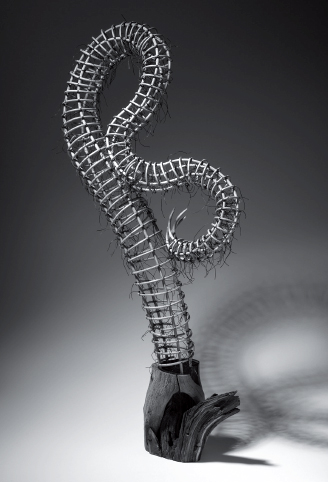
Donna Hapac, “Wiggly” (c)2015
Reed, wood, waxed linen, 32” x 16” x 6”
(Photo supplied by the artist)
Monday, Dec. 4, Chicago sculptor Donna Hapac will open an exhibition at the Hartmann Gallery at Bradley University displaying forms and themes she has explored over the last three decades. I first met Donna in graduate school in the MFA program at Northern Illinois University where we studied painting and drawing with the late Ben Mahmoud. Mahmoud was a charismatic neo-surrealist, constantly in his studio and showing regularly at Deson-Zaks, one of the smarter and more adventurous galleries in Chicago at that time. Despite his own enthusiasm for painting and printmaking as a practice, he wouldn’t let students select a medium that didn’t challenge their initial instincts. He insisted we explore beauty even if we circumvented standard modernist conventions and located it in either our immediate surroundings or in a related discipline, rather than be seduced by what was tilting in the national art press.
That’s a lesson that can take time to come to fruition. Subsequently, Ben’s best students exhibited incremental, methodical growth while some others crashed and burned. Hapac has been exhibiting the rewards of a more introspective exploration of form for years, and it’s gratifying to see how she has rebuked trends toward spectacle in contemporary art. Her work is an example of how local visual narratives, honed in defiance of market trends, curatorial cache, and coastal acceptance can reach critical mass. Recognizing the value of place and contributing to its visual culture redefines where you live. If you ignore it, you risk only being on record for ignoring it.
Hapac’s work turned away from drawing and painting as circumstances made sculpture fresh and available to her – and she exploited it. Her work became contextualized by the side of Chicago anchored in structure and crafted in a space where concept and skill are bonded. Hapac became a member of the Chicago Sculpture International, an organization active in championing sculptors and sculpture production in the region. It’s an affiliate of the Sculpture International Center that publishes Sculpture Magazine and has been a resource for Donna as she subsequently has had numerous one person and group shows, including one at the Contemporary Art Center in Peoria just a few years ago.
Chicagoans, artists and collectors have a big appetite for objects and images that modify the spaces they occupy, rather than simply aestheticizing the environment. The Midwest is known for its enormous space, and its cities aren’t designed to enclose it like they do in the East. Chicago’s urban planning and spare architectural interiors are especially suited for splendid objects – three-dimensional art that magnifies and mediates rather than just reflecting space. Hapac’s work does just that.
Her spiraling, variously-sized sculptures reveal how nature and culture instrumentalize each other. The urban means little without ruralness and that opposition is critical for picturing the world and is buried in most design. My favorite works of Hapac’s are woven volumes of plant life – remarkable pieces that are part nature and part engineering. They’re post-primitive, flora facsimiles, constructed of cane, twine, waxed linen, reeds, aluminum and other materials. The organic frames are akin to Martin Puryear’s early ritual-based work which drew consciously on the rhythmic construction methods of tribal implement design and architecture. Diane Simpson is another loosely allied Chicago artist who plumbs vernacular design history to fashion incredibly
sensitive human-scale artworks that extol the significance of craft.
Hapac’s skeletal structures also reflect a layered planning and building process that is exceptional and imaginative, connecting dots between biology, geography, manual labor and the city’s formidable sculpture tradition.
The reception for Hapac is 5 p.m. to 6:30 p.m. Saturday, Dec. 9 at Hartmann Gallery.

1 comment for “”